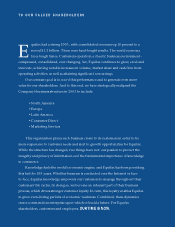Equifax 2003 Annual Report Download - page 19
Download and view the complete annual report
Please find page 19 of the 2003 Equifax annual report below. You can navigate through the pages in the report by either clicking on the pages listed below, or by using the keyword search tool below to find specific information within the annual report.
16 EQUIFAX. INFORMATION THAT EMPOWERS.
M ANAGEM ENT’S DISCUSSION AND ANALYSIS OF FINANCIAL CONDITION AND RESULTS OF OPERATIONS
The following discussion of our financial condition and results of
operations should be read in conjunction with our financial state-
ments and the related notes included in this Annual Report. This
discussion contains forward-looking statements. Please see
“Forward-Looking Statements,” on page 29, and “Risk Factors” in
our Form 10-K filed with the Securities and Exchange Commission
for a discussion of the uncertainties, risks, and assumptions
associated with these statements.
COM PONENTS OF INCOM E STATEM ENT
Revenues from our three reportable segments, Equifax North
America, Equifax Europe and Equifax Latin America, are generated
from a variety of products and services categorized into three
groups: Information Services, Marketing Services, and Consumer
Direct. In 2003, our Equifax North America segment generated 83%
of our worldwide revenues and 89% of our operating profit before
corporate expense.
Information Services revenues are principally transaction related,
and are derived from our sales of the following products, many of
which are delivered electronically: credit reporting and scoring,
mortgage reporting, identity verification, fraud detection and
modeling services, and certain of our decisioning products that
facilitate pre-approved offers of credit that automate a variety of
decisions. Revenues from our Marketing Services are derived from
our sales of products that help customers acquire new customers.
Consumer Direct revenues are transaction related, and are derived
from our sales of credit reporting products and identity theft moni-
toring services, which we deliver to consumers electronically via
the Internet and via mail. Our revenues are sensitive to a variety of
factors, such as demand for, and price of, our services, technologi-
cal competitiveness, our reputation for providing timely and reli-
able service, competition within our industry, federal, state, foreign
and regulatory requirements governing privacy and use of data, and
general economic conditions.
Our operating expenses include costs of services and selling,
general, and administrative expense. Costs of services consist
primarily of data acquisition and royalties; customer service costs,
which include: personnel costs to collect, maintain, and update our
proprietary databases, to develop and maintain software applica-
tion platforms, and to provide consumer and customer call center
support; hardware and software expense associated with transac-
tion processing systems; telecommunication and computer network
expense; and occupancy costs associated with facilities where
these functions are performed. Selling, general, and administra-
tive, or SG&A, expenses consist primarily of personnel costs for
compensation paid to sales and administrative employees and
management. Depreciation and amortization expense includes
amortization of acquired intangible assets.
ADOPTION OF SFAS 142
Beginning January 1, 2002, we adopted Statement of Financial
Accounting Standards No. 142, “Goodwill and Other Intangible
Assets,” or SFAS 142. SFAS 142 modifies the accounting for busi-
ness combinations, goodwill, and identifiable intangible assets.
As of January 1, 2002, all goodwill amortization ceased. SFAS 142
requires an initial impairment test of goodwill and certain other
intangibles to be completed in the year of adoption and annually
thereafter. In 2002, we completed our goodwill impairment testing
required by SFAS 142, which resulted in no adjustment to the
carrying amount of goodwill. Although the adoption of the impair-
ment provisions of SFAS 142 did not have a material impact on our
financial position, we cannot assure you that additional impairment
tests will not require an impairment charge during future periods
should circumstances indicate that our goodwill balances are
impaired. Income from continuing operations for the year ended
December 31, 2001 included after tax goodwill amortization of
$18.5 million ($0.13 per diluted share).
2003 COM PARED TO 2002 – CONSOLIDATED OVERVIEW
In looking at the performance of Equifax in 2003 compared to 2002,
two themes are primary: first, the key events that affected the year’s
results, and second, the actions that we have taken to position our
company for growth in 2004 and beyond. Review of the financial
condition and results of operations of Equifax for 2003 and com-
parison to the prior year incorporates the following key items:
1. Record mortgage-related revenues;
2. Solid performance in our U.S. Information Services;
3. Record performance and market share gains in our
Canadian operations;
4. Continued growth in our Consumer Direct business;
5. Economic stabilization and recovery in Latin America;
6. Strong cash flow from operations; and
7. Our December 2003 charge relating to our
eMarketing business.
























